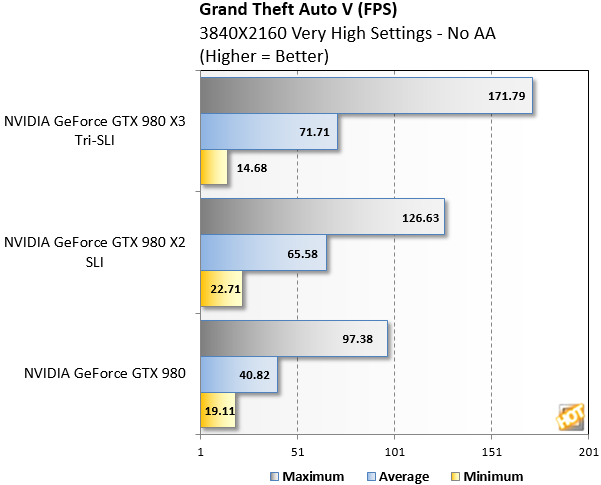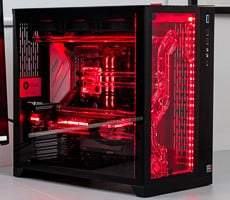Now we'll look at those all-important frame rates, as well as how things scale over 1, 2 and 3 GeForce GTX 980 GPUs in either single card, standard SLI or Tri-SLI modes. There is definitely a sweet spot that becomes apparent here as well, as you'll see.
First we'll look at frame rates at a more pedestrian 2560X1600 resolution, for those who aren't complete pixel snobs.


At 2560 resolution, even with 2X AA enabled at Very High image quality settings, a single GeForce GTX 980 is enough muscle to keep average frame rates north of 50 fps. Also, adding another GPU in two card SLI offers a nice boost but a third card offers very little gain, even at 2X AA settings. NVIDIA is obviously still optimizing multi-GPU scaling in this game title but it's also a fairly CPU intensive, and as such, when things aren't completely GPU-bound, inter-GPU communication overhead appears to rob some performance as well.


Turning things up to 4K resolution and the workload becomes graphics memory bandwidth and GPU bandwidth intensive. With no AA enabled, a single GeForce GTX 980 is able to handle GTA V's 4K workload. However, turn on 2X AA and things crater below 30 fps. Drop in a second GPU and you get all of that frame rate back and then some.
The move from two to three card SLI here also offers appreciable gains though not nearly as pronounced as going from a single card to two. With no AA on, we see roughly a 10% gain for Tri-SLI. With 2X AA turned on, we see nearly a 17 percent gain. Again, the Tri-SLI performance boost isn't nearly as significant as the 67 percent lift we see going from one to two GPUs, but it's at least observable here at 4K resolution.
A Note On GPU Memory Bandwidth vs. Core Clock Speeds
For the record, we spent some time overclocking a single GeForce GTX 980 card both in terms of its core GPU clock and then across its memory interface - again at 4K resolution. Not surprisingly, when we overclocked the GPU by 200MHz over stock (1250MHz for the card we tested with), we saw a nice 10 percent gain. However, when we overclocked the memory by only 200MHz over its stock 3500 DDR clock rate (3700MHz total), we observed nearly a 15% increase in frame rate, and this was at stock GPU core clock. And so, as expected, GPU memory bandwidth at Ultra HD resolutions can actually have more of an impact than GPU throughput in this game, relatively speaking.










